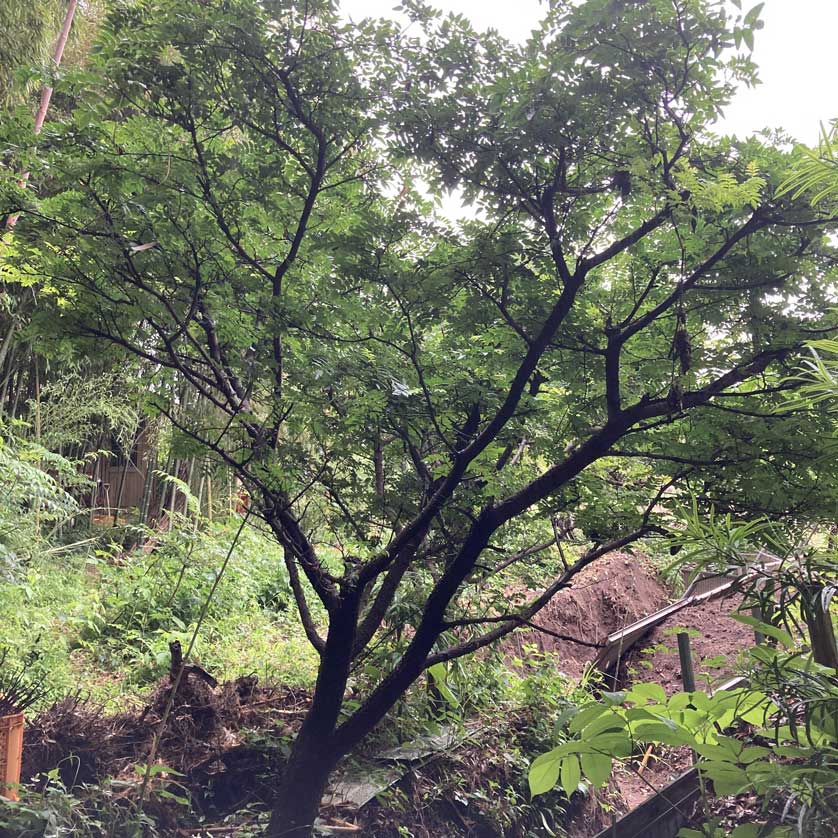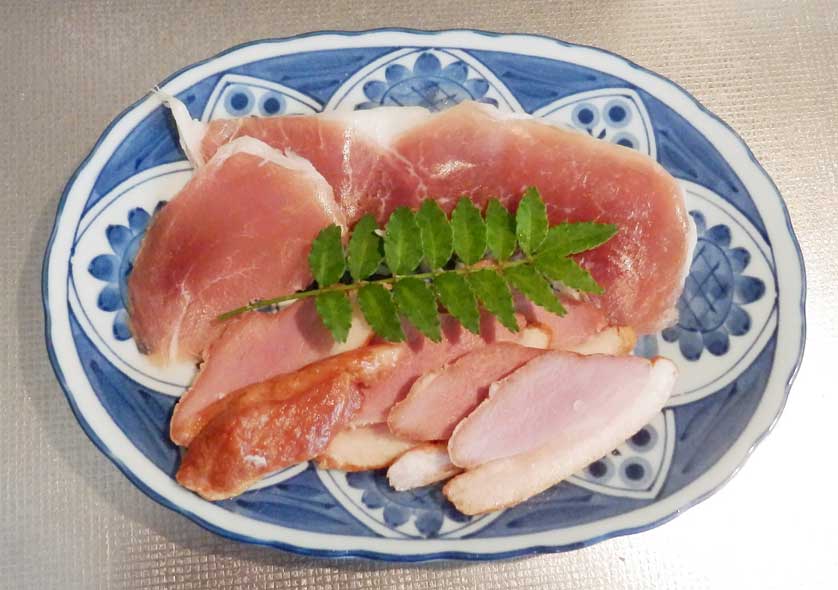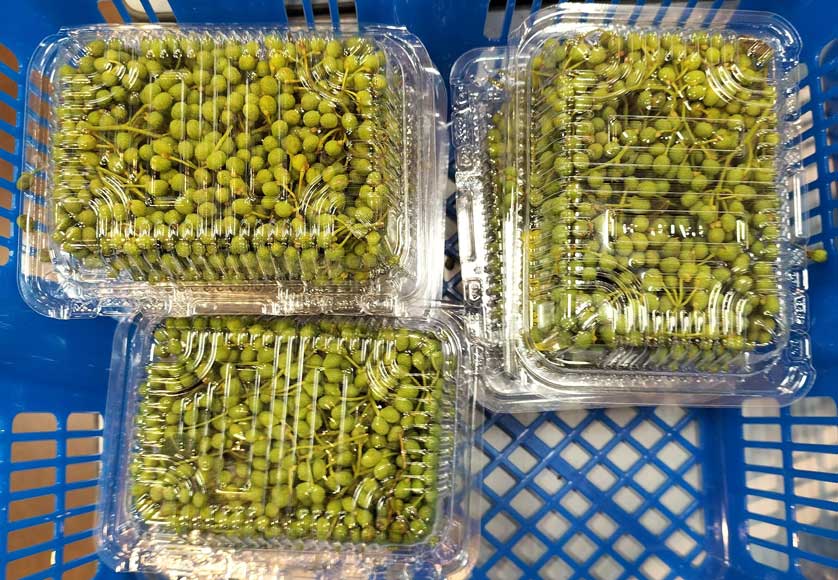Japanese Mountain Pepper - Sansho 山椒
 |
| Sansho fruits on a tree |
Sansho, known as Japanese Mountain Pepper or simply Japanese Pepper in English, is one of the essential spices of Japan. Traditional Japanese eel dishes would be unthinkable without sansho, sansho is an integral component of the widely used shichimi togarashi (Seven Peppers).
Sansho also works great on Western dishes like steak and other meats, it works perfectly with fish of all sorts as well as in salads. The edible leaves of the plant look delicious on any food platter - from sashimi to ham to cheese. The varieties of the use of sansho are almost endless with both Japanese and international dishes.
 |
| Sancho tree in Japan |
What is Sansho?
Biologists use the Latin name Zanthoxylum piperitum for the plant. It is a tree which can grow up to three meters high. It can be easily recognized by its particular pinnated (feather-like) set of leaves and it sports long and quite sharp thorns.
The plant is native to Japan as well as parts of South Korea and a few areas in China. Known as chopi in Korean, sansho is also in heavy use in the cuisine of the Southern part of the peninsula.
Sansho is closely related to Sichuan peppers though their taste differs. Sichuan peppers fit the spicy foods of southwest China while sansho caters to the more subdued and refined tastes of Japan.
 |
| Bamboo sprouts with sancho leaves |
Male and Female Plants
Sansho plants come in two varieties - male and female. Only the female plants feature blossoms (in about April), and only the female plants are able to grow fruits and seeds. Their leaves are larger, darker, and harder than those of their male counterparts.
The male plants on the other hand produce soft and light-colored leaves throughout the spring season. Those leaves are cherished in Japanese cuisine. In department stores, they are often sold in quite extravagant packaging for an according price.
 |
| Casual meat platter with sansho leaves |
Sansho Leaves
This means that sansho from the male and female varieties is sold and used in quite different ways.
In April and May, male sansho leaves are available – going to a farmers' market you find them at a much lower price than at the department stores. Those leaves are fresh and they provide the very best of the sansho taste and smell. They are typically referred to as hana-zansho (flower sansho).
Typically, Japanese will place those leaves on one of their palms, then strongly clap hands. That brings out the full taste the best, it is said. If you get the chance to try your hand on that old custom, you will certainly attest to its veracity.
Those leaves go especially well with the fresh bamboo sprouts heading out of the ground at the same time.
They are very decorative and you often see them in advertising, sometimes used to advertise foods that call for sansho but are offered in different seasons. Like eel, a dish most commonly consumed in summer.
 |
| Unripe sansho fruits for sale in a Japanese farmers' market |
Unripe Sansho Fruits
In June and July, unripe green sansho fruits become available at Japanese farmer's markets and department stores.
Those fruits, called ao zansho (green sansho) are often boiled in a broth with soy sauce and kombu (kelp) to make a tsukudani (rice topping). Mixed with tiny chirimen fish, they make great chirimen zansho, a famed Kyoto dish.
 |
| Ground sansho produced by SB on a Japanese supermarket shelf |
Budoh Sansho
Sansho trees grow all over Japan from Hokkaido to Kyushu. The center of sansho production however is Wakayama Prefecture in Western Japan, south of Osaka. Wakayama cultivates about 80% of Japan's sansho.
Wakayama is also home to a special type of sansho, known as budoh sansho (grape shansho). The fruits of budoh sansho are much larger than average sansho fruits, they look more like grapes, hence the name. The budoh sansho variety is particularly sought after - it is not only larger but also offers a spicier taste than the average sansho.
Budoh sansho is sold both in unripe and in mature form.
 |
| Sansho rinds packed by Mascot |
Ground Sansho
Harvest time for the ripe sansho fruits is in about October. That is when the by then dry reddish fruit rinds break open and reveal a black seed inside.
That seed is inedible and thus gets discarded. The valuable part of the fruit is the dry rind.
Most commonly that rind is ground into a more or less rough powder. Unlike the fresh leaves and unripe fruits, that powder can be purchased and used throughout the year.
Ground sansho is an elemental part of shichimi togarashi, ground sansho is no doubt the most commonly used form of sansho in Japanese kitchens today.
That's what is sprinkled on the dishes in summer in most eel restaurants, that's what you find as a condiment on the tables of Japanese udon and soba noodle restaurants.
The most common variety of ground sansho in Japan is the one manufactured by spice giant SB. Their sansho powder, labeled in hiragana letters as さんしょう, is available in every supermarket. That is the sansho most Japanese use at home.
Sansho Rinds
The main selling point of ground sansho is its convenience. You get the sansho taste on your dishes quickly and reliably.
For the real aficionado, however, ground sansho does not fly. Too much of the taste and fragrance of the sansho invariably evaporates during processing and storing.
Under the name Japanese Pepper, Japanese spice maker Mascot sells the original dried rinds. Rinds of Wakayama budoh sansho, the large and spicy variation of the plant.
You get the real rinds tightly packed into a glass jar. Keep them dry and only use the portion for the meal you plan. Grind them in a suribachi mortar. The suribachi will bring out the best of the taste - especially if it is one of those traditional Japanese mortars that come with a pestle made of fragrant sansho tree wood.
Buy Sancho
Goods from Japan offers a variety of Japanese spices and condiments.
Buy ground sansho pepper from S&B
Purchase a range of Japanese foodstuffs and drinks from GoodsFromJapan.
Related
Aizuwakamatsu Hand Painted Candles
Furikake Tsukudani Rice Topping Kinshobai
Japanese Mortar & Pestle Suribachi & Surikogi
by Johannes Schonherr
© GoodsFromJapan.com
